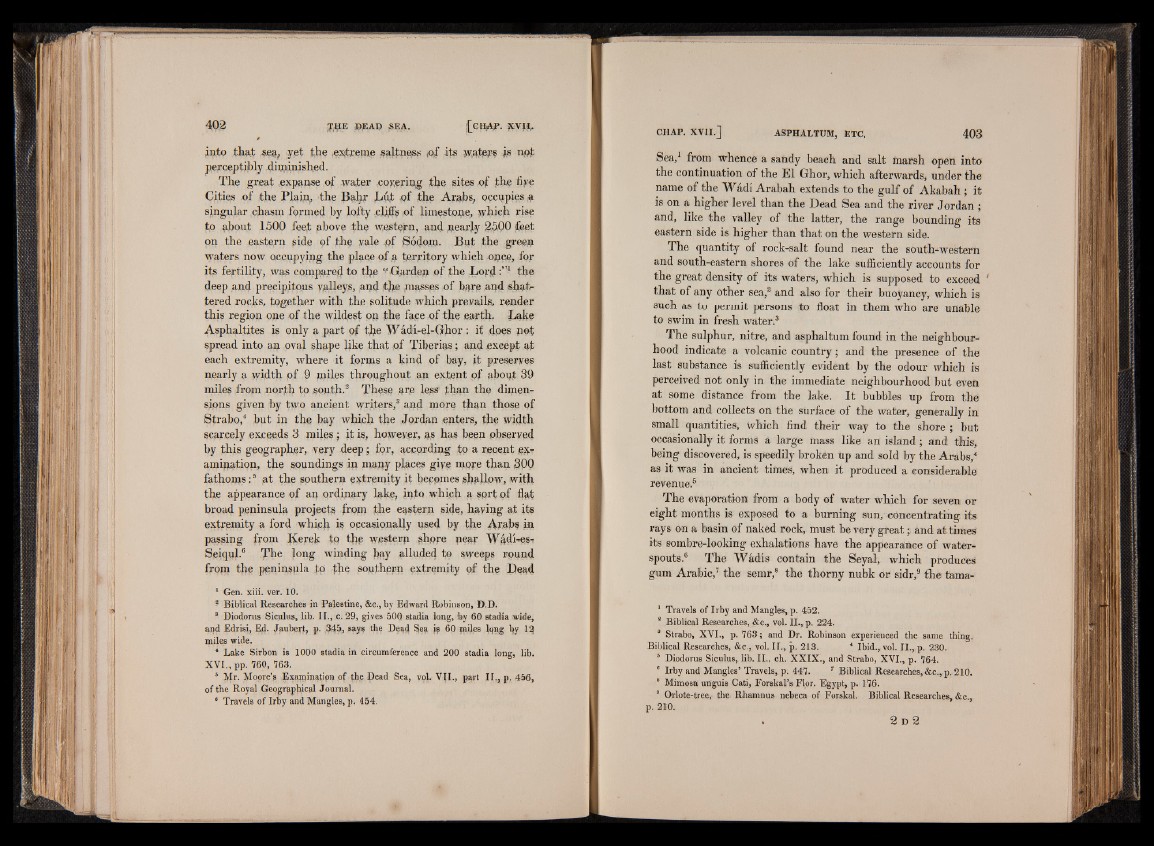
into that sea, yet the ,exfti:eme Apftnqss «of its waters W3 WÍ
perceptibly diminished.
The great .expanse of -water -cohering the sites xjf the dye
Cities .of the Plain, the Bahr fú t -oí the Ar^bs, occupies a
singular chasm formed by lofty clidfh of limestone, which rise
to about 1500 feet above the western, and nearly !2500 ¡feet
on the eastern side of the vale .of tSódom. But the green
waters now occupying the place of a territory which once, for
its fertility, was compared to tlje ‘‘‘Garden of the Lord the
deep and precipitous valleys, and the masses of bare and shattered
rocks, ¡together with the solitude winch prevails, render
this region one of the wildest on the fare of the earth- Lake
Asphaltites is only a part of the W ádí-el-Ghor : if does not
spread into ap oval shape like that of Tiberias; and except at
each extremity, where it forms a kind of bay, it preserves
nearly a width pf 9 miles throughout an extent of about 39
miles from north to south-2 These are less than the dimensions
given by two ancient writers, 3 and more fhan those of
Strabo,4 but in the bay which the Jordan enters, the width
scarcely exceeds 3 miles 5 it is, however, aa has been observed
by this geographer, very deep; for, according to a repent ex’-
amipation, the soundings in many places giye mofe than #09
fathoms ;• at the southeriji extremity if beppmes shallow, with
the appearance of an ordinary lake, into which a ®prf of flat
broad peninsula projects from the eastern side, haying at its
extremity a ford which W opcasionally used by the Arabs in
passing from fierek to the westerp shore neap WÁdí’PS-
Seiqul-6 The long winding hay alluded to sweeps round
froin the peninspla to the southern extremity of the Dead
1 Gen. xiii. ver. 10.
* Biblical Researches in Palestine, &c., by Edward Robinson, D.D.
8 Diodorus Siculus, lib. II., c. 29, gives 509 stadia long, by 60 stadia wide,
and Edrisi, Erf- Jaubeyf, p. 345, says the Dearf j? 60 pailes Jcjpg l}y lg
miles wide.
4 Lake Sirbon is 1000 stadia in circumference and 200 stadia long, lib.
XVI., pp. 760, 763.
5 Mr. Moore's ]Exajninatipn of the Dead Sea, vol. VII., pgrt II., p. 456,
of the Royal Geographical Journal.
8 Travels of Irby and Mangles, p. 454.
Sea,1 from whence a saudy beach and salt marsh open into
the continuation of the El Ghor, which afterwards,- under the
name of the Wadi Arabah extends to the gulf of Akabah ; it
is on a higher level than the Dead Sea and the river Jordan ;
and, like the valley of the latter, the range bounding its
eastern side is higher than that on the western side.
The quantity of rock-salt found near the south-western
and south-eastern shores of the lake sufficiently accounts for
the great density of its waters, which is supposed to exceed 1
that of any other sea,2 and also for their buoyancy, which is
such as to permit persons to float in them who are unable
to swim in fresh water,3
The sulphur, nitre, and asphaltum found in the neighbourhood
indicate a volcanic country; and the presence of the
last substance is sufficiently evident by the odour which is
perceived not only in the immediate neighbourhood but even
at some distance from the lake. It bubbles up from the
bottom and collects on the surface of the water, generally in
small quantities, which find their way to the shore ; but
occasionally it forms a large mass like an island; and this,
being discovered, is speedily broken tip and sold by the Arabs,4
as it was in ancient times, when it produced a considerable
revenue.5
The evaporation from a body of water which for seven or
eight months is exposed to a burning sun, concentrating its
rays on a basin of naked rock, must be very great; and at times
its sombre-looking exhalations have the appearance of waterspouts.
6 The Wadis contain the Seyal, which produces
gum Arabic,7 the semr,8 the thorny nubk or sidr,9 the tama-
1 Travels of Irby and Mangles, p. 452.
8 Biblical Researches, &c„ vol. II., p. 224.
8 Strabo, XVI., p. 763; and Dr. Robinson experienced the same thing.
Biblical Researches, &c., vol. II., p. 213. 4 Ibid., vol. II., p. 230.
5 Diodorus Siculus, lib. II., ch. XXIX., and Strabo, XVI., p. 764.
6 Irby and Mangles’ Travels, p. 447. 7 Biblical Researches, &c., p. 210.
8 Mimosa unguis Cati, Forskal’s Flor. Egypt, p. 176.
8 Orlote-fcree, the Rhamnus nebeca of Forskal. Biblical Researches,. &c.,
p. 2X0.
2 D 2